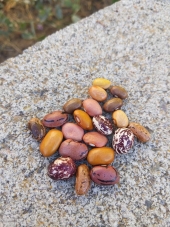1 year update! We squeezed in two plantings this year. Since I only mentioned one last time, here are the ancestral varieties:
-Good Mother Stallard:
https://shop.seedsavers.org/good-mother-stallard-bean
-Sawaroame:
https://www.nativeseeds.org/collections/common-beans/products/pc047
-Vayo Wapibawi:
https://www.nativeseeds.org/collections/common-beans/products/pc023
-O'odham Pink:
https://www.nativeseeds.org/collections/common-beans/products/pc063
-Purple Hopi:
https://www.nativeseeds.org/products/pc102
-Sonoran Canario:
https://www.nativeseeds.org/products/pc082
-Rattlesnake:
https://www.nativeseeds.org/collections/common-beans/products/ts305
The good news is that my suspicion was right: my wife's reluctance to grow anything but Good Mother Stallard was largely due to the fact that it was the first heirloom variety we tried. Because it tasted so much better than the commercial varieties we grew up with, she was led to believe they were uniquely exceptional. And while their flavor in fact quite excellent, they are not unique: we are in agreement that the Sawaroame, O'odham Pink, and Purple Hopi are every bit as delicious (Purple Hopi is my personal favorite). The Vayo Wapibawi and Rattlesnake are not as exciting flavor-wise, but the Vayo Wapibawi seem to put out new pods for quite a while, and the rattlesnakes grow like gangbusters (in warm weather). Since these are desirable traits, I'm keeping them around to contribute to the gene pool.
The Sonoran Canario was the least exciting of all the varieties. I was intrigued to learn that they are traditionally grown in winter, so I kept them around until after the second planting of the year, when the weather was quite a bit cooler, just to see how it fared. But when it didn't seem to outperform any of the other varieties, nor did I see obvious signs of its influence in any of the crosses that have popped up so far, I decided to not plant it anymore.
Oh yes, crosses. Knowing that common beans have relatively low cross rates, I was expecting to have to wait years before I saw any noticeable differences, but boy was I wrong! I saw one obvious cross after first harvest, and four more after the second!
Generation 1, minus Sonoran Canario (I can't seem to figure out how to attach images):
https://drive.google.com/u/0/drive-viewer/AKGpihbOjHXNF8oKBbtSYcEEdeEOmJed7lBCPQ8oDkTOYS9Vyzx_CQkOVN8FY8UVrqRPak83UJ5jXbMMJMQsz4nJn8pfPFQrVoiz2g=s1600-rw-v1
Generation 2, minus Sonoran Canario and Good Mother Stallard:
https://drive.google.com/u/0/drive-viewer/AKGpihYoTVa9qHfqNnW6OPymxRD2idm0ZEds8KXrz7z4jDucYFzwncFcBGHYUysqQWTjVrnC-OJvpkEMSLIk_toUPyimxDbASZcE7w=s1600-rw-v1
The second planting (with the cooler weather) saw noticeably more powdery mildew crop up than the first, and it was over-represented on the Good Mother Stallard plants. So I decided to try developing two landraces: one for warm weather, and one for "cold weather" (you know, by Los Angeles standards). I'm using the harvest from the second planting as the base for my cold weather landrace, and since we no longer fear for the flavor of our landrace without Good Mother Stallards, I removed them from the mix. And while I may change my mind in the future about maintaining a separate cold weather landrace, for now I've decided to give it a true trial by fire: I just made a third planting of the year (planted November 24)! We'll see what it manages to produce over coldest part of year. We do typically get a few frost days per year, so that may be too much for them to endure. I guess we'll find out!
Lastly, a picture of the trellis I settled on (after trying a few different configurations of bean poles). I have four drip lines running the length of the bed, corresponding to four rows of bean plants. Two rows of plants share one row of twine trellises, equaling roughly four plants sharing a single twine as they climb to the sky (the theory being that close quarters will encourage crosses).
https://drive.google.com/file/d/1DidB_zFySfpRRIuns8HQ5j82xqY3Ez-d/view








